Abstract
In order to monitor proper growth and development in a particular sport, body composition monitoring has a great significant, which gives clear indicators about the state of trainings and nutritional status of young athletes. It is very important to analyze physical system in soccer players, not only to evaluate variations of dimensions in quantitative and qualitative meaning, but also in a direction of soccer players selection in the certain competitive categories and for a certain team position. Therefore this research had the primarily aim to analyze the trend of body composition in different periods of soccer players’ career. The total sample of respondents (n = 271) is consisted of seven sub-samples of different age categories of soccer players competing in Bosnia and Herzegovina, U10 (n = 28), U12 (n = 54), U13 (n = 48), U14 (n = 62), U16 (n = 27), U18 (n = 24) and seniors (n = 28). The subject of this study included the body composition of soccer players in order to analyze the trend of dimension changes during soccer career. The changes in dimensionality are analyzed by one – way analysis variance (One way ANOVA) which is the simplest model from a large family techniques dealing with analysis of variance. Analysis results showed that soccer players during their career have had a very dynamic pace of growth and development, with specific periods in which it is accelerated or slowed down. In the period since beginning of dealing with soccer to the period of senior stuff, occurs the continued growth appears with the indicators that define the height, mass, basal metabolism, amount of the fluid in the body and the amount of fat free mass in the body composition. The variable that define the body mass index (BMI ), body resistance (IMPEDANCE), percentage (FAT %) and mass portion of fat tissue in body structure (FATMASS) changes of dimensionality have a different pace and sign of movement. It can be concluded that soccer players during their career have rapid growth in height, whose largest increase is between the age period of 13 and 14 (10,21 cm), they linearly gain in mass whose largest increase is between the age period of 13 and 14 (8,7 kg) and between the age period of 16 and 17 (9,1 kg). We have a continuous increase in dimensions of indicators of basal metabolism, fat tree body mass and amount of fluid in the body. Changes in body resistance, amount and percentage of fat in the overall body mass have different signs depending on the age and growth competing category and have fall of values till the age period of 18.


